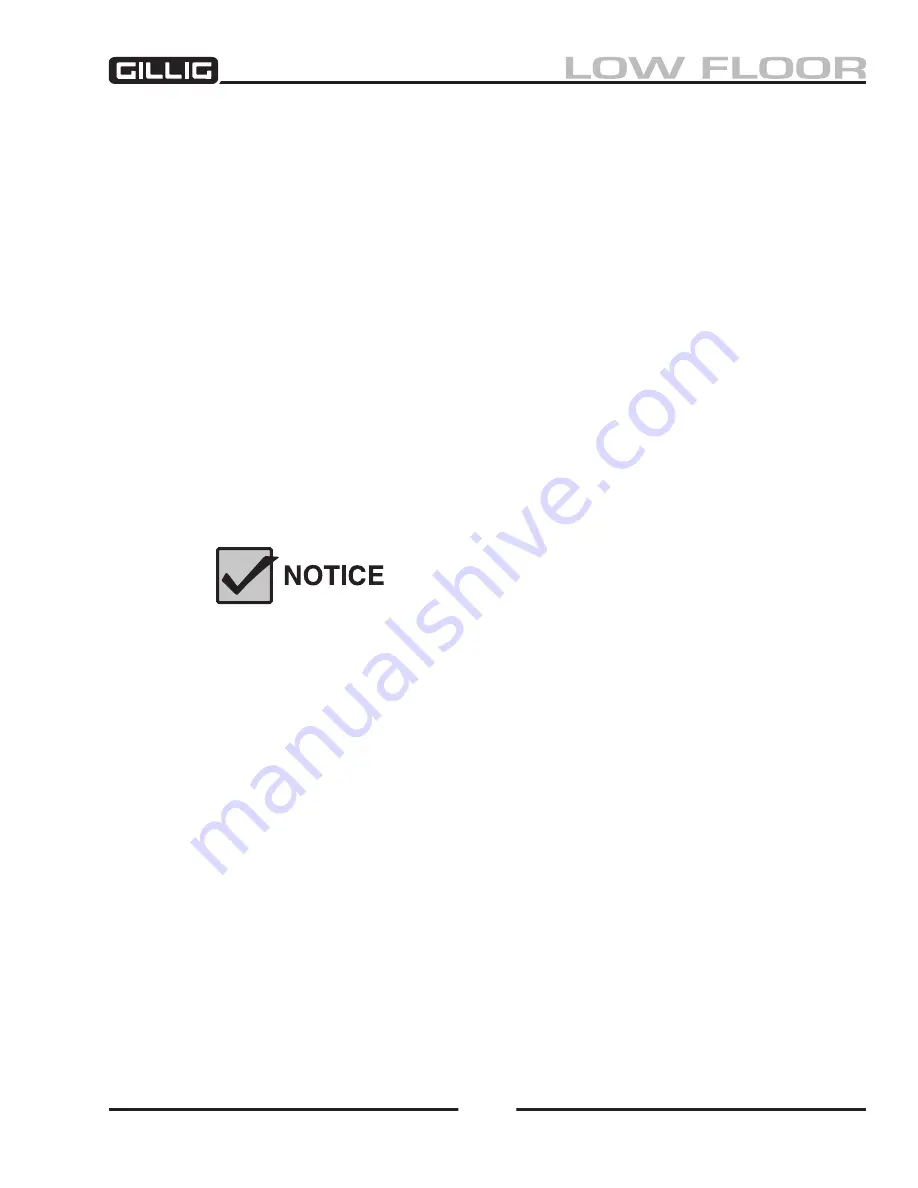
Body and Interior
443
Chapter – Body and Interior
UNDERBODy
An underseal is sprayed onto the bottom of the chassis to protect the underbody from corrosion caused
by exposure to and/or accumulation of caustic elements, particularly road salt and de-icing sprays. Typi
-
cally, the underseal will last the lifetime of the vehicle, as long as it remains intact and undamaged by
gravel, debris, road salt, etc. The underbody
must
be checked regularly to ensure that the protective coat-
ing is in good condition. The underseal should be inspected every three months or 12,000 miles (more
often in areas with heavy corrosion problems) and reapplied if necessary. If a small area is damaged, you
can repair it with a spray underbody coating, such as 3M rubberized undercoating or Krylon 1335. Areas
requiring special attention are the wheel arches and the area around and behind the rear wheels. If a large
section is damaged, use a water-base undercoating such as PPG CoraShield 7972. Contact your Gillig
Service representative for more information. If there is a bare, rusted section on the underbody, Gillig
recommends the use of Extend
®
, a Loctite
®
rust-treatment product. Then apply undercoating. Contact
your Gillig Parts representative at (800) 735-1500 for approved undercoating and rust-treatment prod-
ucts.
All air bags and other rubber components should be masked to protect them from the under-
coating, which will damage the rubber.
The undercoating and understructure should be hosed off and inspected
frequently and undercoating reapplied if necessary. Pay special attention
to the undercoating in the wheel arches and the area around and behind
the rear wheels. Corrosion will result from deteriorated undercoating.
Corrosion Protection
The chassis and underbody components are designed and manufactured to maximize strength, durability,
reliability, and corrosion resistance. Without regular maintenance, however, normal wear and tear, road
debris, road salt, and the newer chemical de-icers will damage and corrode these components.
Of particular concern are the newer chemical anti-icers and de-icers, which state and county authori-
ties began using in the late 1990’s and early 2000’s. These new de-icers, such as
magnesium chloride,
calcium chloride, and similar solutions and acetates
, are generally more effective, less costly, and
less environmentally harmful than traditional road salt (sodium chloride), but they are also
significantly
more corrosive
. They attack virtually all metals, and they even corrode stainless steel, aluminum, and
other materials that normally resist corrosion from road salt. These de-icers are usually applied in liquid
form. When kicked up by vehicle tires, the liquid de-icer becomes a mist that settles all over the bus and
even wicks into structural joints and electrical connectors. In addition, the de-icer chemicals are “sticky,”
so their residue does not easily wash off, and they start corroding bus components within 72 hours. They
are hydrophilic (attracting moisture from the air), which means that galvanic corrosion can continue all
year long. (Road salt stops corroding when dry and can be easily washed off.) The result is that these
chemicals corrode vehicle components
five or more times faster
than road salt. Fleet owners report cor-
Содержание LOW FLOOR
Страница 18: ...Specifications 18...
Страница 58: ...Preventive Maintenance 58...
Страница 110: ...Engine 110...
Страница 138: ...Transmission Driveline Rear Axle 138...
Страница 182: ...Suspension 182...
Страница 260: ...Air System 260...
Страница 420: ...Electrical System 420 Deutsch DT Series Connectors...
Страница 421: ...Electrical System 421...
Страница 422: ...Electrical System 422 Deutsch HD 10 Series Connectors...
Страница 423: ...Electrical System 423...
Страница 424: ...Electrical System 424 Deutsch HD 30 Series Connectors...
Страница 425: ...Electrical System 425...
Страница 442: ...Heating Air Conditioning 442...
Страница 486: ...Body and Interior 486 Driver s Seat Troubleshooting Use the following chart to troubleshoot the USSC seat...
Страница 492: ...Body and Interior 492 Figure 11 33 USSC Seat Assembly...
Страница 493: ...Body and Interior 493 Figure 11 34 USSC Seat Suspension Assembly...
Страница 495: ...Body and Interior 495 Figure 11 37 Seat Air Connections...
Страница 506: ...GILLIG CORPORATION 25800 Clawiter Road Hayward CA 94545 Phone 510 785 1500 Fax 510 785 6819 Printed November 2006...






























